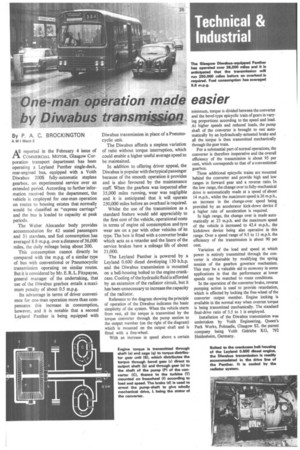By P. A. C. BROCKINGTON A M I Mech E
Page 37

If you've noticed an error in this article please click here to report it so we can fix it.
Areported in the February 4 issue of COMMERCIAL MOTOR, Glasgow Corporation transport department has been operating a Leyland Panther single-deck, rear-engined bus, equipped with a Voith Diwabus 200S fully-automatic stepless gearbox. on experimental service over an extended period. According to further information received from the department, the vehicle is employed for one-man operation on routes to housing estates that normally would be classified as "express carriage" and the bus is loaded to capacity at peak periods.
The Walter Alexander body provides accommodation for 42 seated passengers and 31 standees, and fuel consumption has averaged 8.8 m.p.g. over a distance of 36,000 miles, the daily mileage being about 200.
This consumption cannot directly be compared with the m.p.g. of a similar type of bus with conventional or Pneumocyclic transmission operating on similar routes. But it is considered by Mr. E. R. L. Fitzpayne, general manager of the undertaking, that use of the Diwabus gearbox entails a maximum penalty of about 0.5 m.p.g.
Its advantage in terms of driver convenience for one-man operation more than compensates this increase in consumption, however, and it is notable that a second Leyland Panther is being equipped with Diwabus transmission in place of a Pneumocyclic unit.
The Diwabus affords a stepless variation of ratio without torque interruption, which could enable a higher useful average speed to be maintained.
In addition to offering driver appeal, the Diwabus is popular with the typical passenger because of the smooth operation it provides and is also favoured by the maintenance staff. When the gearbox was inspected after 35,000 miles running, wear was negligible and it is anticipated that it will operate 250,000 miles before an overhaul is required.
Whilst the use of the transmission as a standard feature would add appreciably to the first cost of the vehicle, operational costs in terms of engine oil consumption and tyre wear are on a par with other vehicles of its type. The box is fitted with a converter brake which acts as a retarder and the liners of the service brakes have a mileage life of about 21,000.
The Leyland Panther is powered by a Leyland 0.600 diesel developing 130 b.h.p. and the Diwabus transmission is mounted on a bell-housing bolted to the engine crankcase. Cooling of the hydraulic fluid is afforded by an extension of the radiator circuit, but it has been unnecessary to increase the capacity of the radiator.
Reference to the diagram showing the principle of operation of the Diwabus indicates the basic simplicity of the system. When the vehicle starts from rest, all the torque is transmitted by the torque converter through the pump section to the output member (on the right of the diagram) which is mounted on the output shaft and is fitted with a free-wheel.
With an increase in speed above a certain minimum, torque is divided between the converter and the bevel-type epicyclic train of gears in varying proportions according to the speed and load. At higher speeds and reduced loads, the pump shaft of the converter is brought to rest automatically by an hydraulically-actuated brake and all the torque is then transmitted mechanically through the gear train.
For a substantial part of normal operations, the converter is therefore inoperative and the overall efficiency of the transmission is about 95 per cent, which corresponds to that of a conventional gearbox, Three additional epicyclic trains are mounted behind the converter and provide high and low ranges in forward gear and a reverse ratio. In the low range, the change over to fully-mechanical drive is automatically made at a speed of about 14 m.p.h., whilst the maximum speed is 26 m.p.h., an increase in the change-over speed being provided by an accelerator kick-down device if a higher rate of acceleration is required.
In high range, the change over is made automatically at 23 m.p.h. and the maximum speed of the vehicle is increased to 42.4 m.p.h., the kickdown device being also operative in this range. Over a speed range of 9.5 to 11 m.p.h. the efficiency of the transmission is about 90 per cent.
Variation of the load and speed at which power is entirely transmitted through the converter is obtainable by modifying the spring tension of the gearbox governor mechanism. This may be a valuable aid to economy in some applications in that the performance at lower speeds can be matched to route conditions.
In the operation of the converter brake, reverse pumping action is used to provide retardation, which is effected by locking the free-wheel of the converter output member. Engine locking is available in the normal way when overrun torque is being transmitted mechanically. The standard final-drive ratio of 5.5 to 1 is employed.
Installation of the Diwabus transmission was undertaken by Voith Engineering, Queen's Park Works, Polmadie, Glasgow S2, the parent company being Voith Gelriebe KG, 792 Heidenheim, Germany.




















































































































